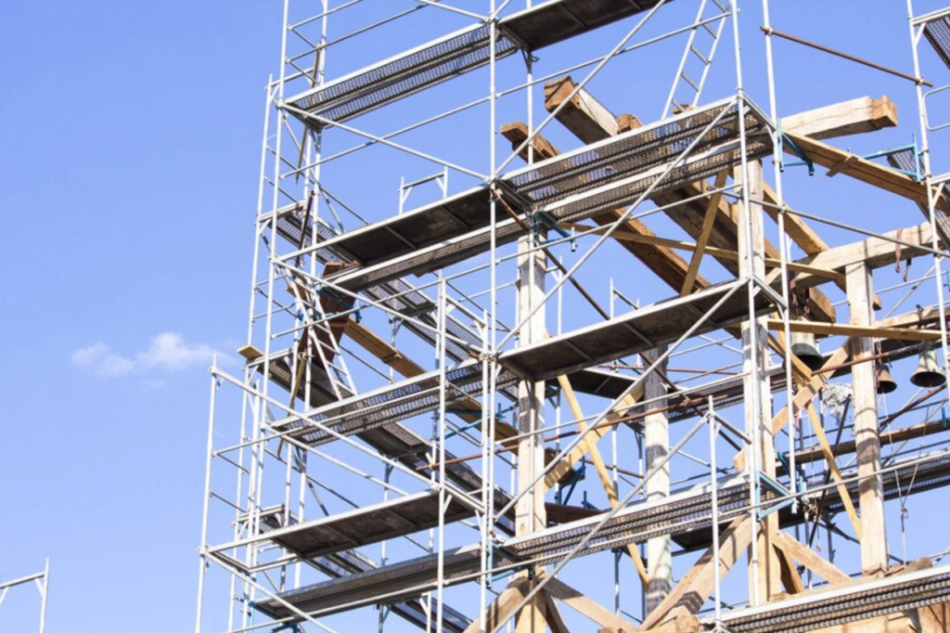
A scaffold is a temporary structure or working platform on the outside of a building. Typically made of a series of metal poles and wooden/metal planks, it is used by construction professionals when building, repairing, cleaning, or painting a structure. It is an essential piece of construction equipment for accessing upper stories of tall buildings and other hard-to-reach areas.
With that said, scaffolds can be quite dangerous when not properly constructed. OSHA reported 2,835 scaffold violations in FY 2023, with many breaches directly linked to inadequate planking. To ensure the safety of all workers and guarantee compliance with all OSHA codes, it is critical to understand scaffold plank load capacity and select the appropriate scaffolding planks or walkboards.
Scaffold Plank Load Capacity
To determine a scaffold's maximum intended load, OSHA declares that a scaffold and its components must be able to accommodate its own weight and a minimum of four times its intended load, which consists of all workers, equipment, and materials. To help streamline this calculation, OSHA has three distinct categories for quantifying load-bearing capacities of scaffolding planks:
- Light-Duty – these planks can accommodate 25 pounds per square foot (psf) when applying weight uniformly. This type of plank is used primarily for inspections and short-term jobs that will not require extensive materials or equipment.
- Medium-Duty – these planks can accommodate 50 psf. This is one of the most common plank capacity grades as it can generally support more than one worker and most types of equipment safely.
- Heavy-Duty – these planks can accommodate 75 psf or more. As their name implies, these are the most robust scaffolding planks and guarantee safety when working with heavy materials and equipment.
To determine the total load capacity of a scaffolding surface, simply take this base rating and multiply it by the total working area on the scaffold. If the working surface uses heavy-duty planks (75 psf) and has a 5x10 platform (50 square feet), then the total weight capacity of the surface would be 3,750 pounds (75 x 50).
Deflection Testing for Load Capacity
Deflection is the bend in a scaffolding plank when introduced to a load. As longer planks will deflect slightly more than shorter planks, OSHA has set guidelines for deflection testing as another means of determining scaffold plank load rating. The guidelines state that deflection may not exceed more than 1/60th of the span between supports.
Scaffolding Planks (Walkboards) Built for High-Load Capacity
When it comes to innovative scaffolding planks that exceed OSHA standards for safety, Bil-Jax is the most trusted name in the industry. With a wide selection of medium- and heavy-duty walkboards, Bil-Jax offers scaffolding for construction professionals that have the load capacity to handle any kind of project.
TUF-N-LITE Walkboard
The Bil-Jax TUF-N-LITE Walkboard is the most widely used industrial-grade scaffolding plank on the market. Fabricated from ½-inch finished plywood decking and heavy-duty aluminum I-beam side rails, the TUF-N-LITE Walkboard comes in various lengths and widths that offer load capacities of up to 75 psf.
X-TRU-LITE Walkboard
The Bil-Jax X-TRU-LITE Walkboard uses a 3-hook, deck interlock design for continuous decking. In addition, its grooved aluminum surface offers no-slip features for enhanced safety.
X-PANDED Steel Walkboard
The Bil-Jax X-PANDED Steel Walkboard employs an expanded galvanized steel mesh design that does not allow liquid, dirt, mortar, or any other type of debris to accumulate on the platform surface. It also uses offset hooks for continuous decking.
Steel Walkboard
The Bil-Jax Steel Walkboard offers the highest quality and durability standards on the market. Coming in lengths of 7, 8, and 10 feet with a narrow width of 9 inches for each span, this premium-duty walkboard offers an astounding 140 psf for its 7-foot option.
Checking Scaffold Planks for Safety
Even when adhering to the strictest OSHA parameters for load capacity and deflection, regular inspections are critical to ensuring the ongoing health and safety of scaffold planks. Some common issues identified during inspections include:
- Weathered or Damaged Plywood: Rainwater and moisture can collect on the boards, leading to rot and degradation over time.
- Foreign Substances: Paint, mortar, or other substances can obscure damage and compromise the board's structural integrity.
- Damaged Aluminum Side Rails: Inspect side rails for bends, cracks, or other signs of damage.
- Damaged Hooks: Hooks that are bent or cracked may fail to securely attach the plank.
- Missing Wind Latches: Wind latches prevent walkboards from being uplifted—more than 50% of boards miss these critical components.
Best Practices for Scaffold Plank Inspections
- Check for Deflection: Planks holding a visible bend when not loaded should be replaced.
- Inspect for Splits, Checks, and Notches: Retire planks with splits; replace those with checks/notches deeper than ¼ inch.
- Examine for Splinters and Rough Edges: Address any sharp edges or splinters.
For additional safety information, check out our article “12 Important Scaffolding Safety Tips”.
Contact Bil-Jax for the Highest Load Rated Scaffolding Walkboards
Many scaffolding injuries and OSHA violations can be avoided by choosing the correct planks that offer adequate load-bearing capacity. For help choosing the best walkboard solutions for your scaffolding project, contact Bil-Jax today for a consultation.
